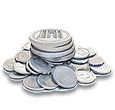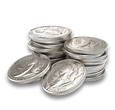How to Value Your Coin Before Selling: A Complete Guide for Collectors & Investors
- GoldsilverJapan

- Sep 7
- 5 min read
Whether you're downsizing your collection, cashing in on a precious metals rally, or simply curious about your coin's worth, knowing how to value your coin before selling is essential.
This guide is designed to answer key questions collectors and investors ask
“How do I find out what my coin is worth?”
“How much should I sell my coin for?”
“How do I appraise a coin at home?”
“Do old coins have value?”
“What factors determine a coin’s value?”
We’ll walk you through every important aspect of coin valuation—from identifying the coin to understanding the market, and how to avoid rookie mistakes.
🧠 Why Knowing Your Coin’s Value Matters
Before listing your coin for sale, you should know what you have—and what it’s worth. If you don’t, two things might happen:
You underprice it, losing potential profit.
You overprice it, and it won’t sell—or worse, you'll waste time and money trying to sell something at an unrealistic price.
This isn’t just about profit—it’s about making informed, strategic choices as a collector or investor.
🪙 Step 1: Identify Your Coin Accurately
The most basic, yet crucial step is identification. You need to know exactly what you're holding.
🔍 Key Details to Look For:
Country of origin
Year and mint mark
Denomination (e.g., 1 Dollar, 10 Yen, 20 Francs)
Metal content (e.g., gold, silver, copper-nickel)
Design elements (monarchs, animals, emblems, etc.)
Any error or variation
🛠 Tools for Identification:
Google Lens or photo search
Numista.com – perfect for world coins
NGC World Coin Identifier
Books like “The Red Book” (U.S. coins) or Krause’s World Coin Catalog
Apps like Coinoscope (great for visual recognition)
📈 Step 2: Understand the Factors That Determine Coin Value
Not all coins are created equal—even if they look the same. Here’s what matters most:
1. Metal Content / Bullion Value
If your coin is made of silver, gold, platinum, or palladium, its spot value can form the base value.
💡 Example: A 1 oz gold coin contains approximately $3,500 worth of gold based on current market prices.
2. Rarity / Mintage
The fewer coins that were minted or survived, the more valuable it usually is.
Low mintage years
Varieties or errors
Destroyed, melted, or recalled coins
3. Condition / Grade
Condition is hugely important. A rare coin in poor condition may be worth less than a common coin in perfect condition.
Uncirculated or Proof coins = higher value
Grading scale from Poor (P-1) to Mint State (MS-70)
Professional grading by PCGS, NGC, ANACS
4. Demand
A coin may be rare, but if nobody wants it—it won’t fetch a good price.
Popular themes that increase demand:
Historical figures (e.g., Queen Elizabeth II, Lincoln)
Limited commemoratives (e.g., Libertad, Britannia)
Country-specific coins (e.g., Japanese 50 Sen, U.S. Morgan Dollar)
🔬 Step 3: Use Online Resources to Estimate Value
Once you’ve identified your coin, use reputable sources to estimate value.
🔎 Trusted Resources:
Platform | Best for | Notes |
PCGS Price Guide | U.S. graded coins | Based on market data |
NGC Price Guide | U.S. + world coins | Great for graded and ungraded |
Numista | World coin collectors | Includes user-generated average sale prices |
eBay Completed Sales | Real-world prices | Search “sold items,” not just listings |
Live Bullion Trackers | Spot price-based coins | Check Kitco, APMEX, GoldSilver.com |
Pro tip: Avoid just looking at listings. Focus on completed or sold listings—that’s what buyers are actually paying.
💼 Step 4: Understand the Role of Coin Grading
Grading is the process of evaluating a coin’s condition. It can drastically change the coin’s value.
Grading Tiers:
Circulated (VG, Fine, XF): Worn, but still collectible
Uncirculated (MS60+): No wear, may have bag marks
Proofs (PR, PF): Mirror-like, made for collectors
SP (Specimen): Special minting process, semi-prooflike
Professional Grading Services:
PCGS (Professional Coin Grading Service)
NGC (Numismatic Guaranty Company)
ANACS, ICG
Having your coin professionally graded provides:
Authentication
Market trust
Liquidity boost for selling
💰 Step 5: Calculate the Premium Over Spot (If Bullion Coin)
Use this simple formula:
Coin Premium = (Coin Price – Spot Price) / Spot Price × 100
📊 Examples Based on Today’s Spot Prices:
Gold Spot: $3,500/oz
Silver Spot: $42/oz
Platinum: $1,500/oz
Palladium: $1,350/oz
Example: A 1 oz Silver Eagle sells for $50
Premium = ($50 – $42) / $42 × 100 = 19.05%
Higher premiums indicate collector or demand value beyond metal content.
📦 Step 6: Evaluate Market Conditions
Sometimes it’s not just about the coin—it’s about timing.
Market Influences:
Precious metals spot price trends
Inflation and economic instability
Currency strength (e.g., USD, JPY, EUR)
Government policy on precious metals or imports
Numismatic demand cycles
Don’t just compare a coin’s price to its past—compare it to other assets, like stocks, bonds, or real estate.
🧾 Step 7: Decide Where You Plan to Sell
Where you sell affects how much you’ll make.
🏪 In-Person Dealers:
Local coin shops (LCS)
Bullion dealers
✅ Fast cash❌ May offer less than online market
🌐 Online Platforms:
eBay (great exposure, fees apply)
Yahoo Auction Japan
Mercari
Bullion dealer buyback programs (like APMEX, GoldSilverJapan)
✅ Wider reach❌ Requires good photos, descriptions, shipping
🧠 Pro Tip:
Coins with collector demand or proof versions do better online, while bullion is easy to sell locally.
⚠️ Step 8: Avoid These Common Mistakes
Not checking spot price first
Selling without knowing rarity
Ignoring condition and grade
Using outdated price guides
Relying only on one buyer
Overvaluing semi-numismatic or themed coins (e.g., Disney, Star Wars)
Selling in a panic during a market dip
🧭 Final Thoughts: Know Before You Sell
Valuing your coin properly isn’t just about numbers—it’s about understanding the coin, the market, and your goal.
Recap Checklist Before You Sell:
✅ Identify your coin completely✅ Check mintage and rarity✅ Know the metal content✅ Get a grade (or professional opinion)✅ Compare to recent sales and online price guides✅ Decide whether to sell for quick cash or best price✅ Watch for market timing✅ Avoid rushing or panic-selling
🗣 FAQ – Frequently Asked Questions
Q: Can I value my coin using an app?
Yes. Try Coinoscope, NGC Coin Lookup, or PCGS Cert Verification. These can help identify and compare quickly.
Q: Should I always get coins graded before selling?
Not always. Grading makes sense for rare, high-value, or uncertain-condition coins. For bullion or junk silver, it’s not usually worth it.
Q: Is older always better?
Not necessarily. Modern coins (like 2020s Libertads or Proof Britannias) can have high value due to low mintage or perfect condition.
Q: What’s the difference between numismatic and bullion value?
Bullion = based on metal weight.Numismatic = collector-driven, based on rarity, condition, and demand.
🏁 Conclusion
When it comes to selling your coin, knowledge is profit.
Don't let your coin go undervalued. Don’t guess—verify. Take time to do research, look at multiple data points, and approach your sale like a professional.
If your goal is maximum return, then coin valuation is not optional—it’s your first and most important step.
👉 Have a valuable coin? Try running it through PCGS or NGC. Or get a second opinion before you sell.
Stay informed, stay sharp—and don’t sell your coin short.











Comments